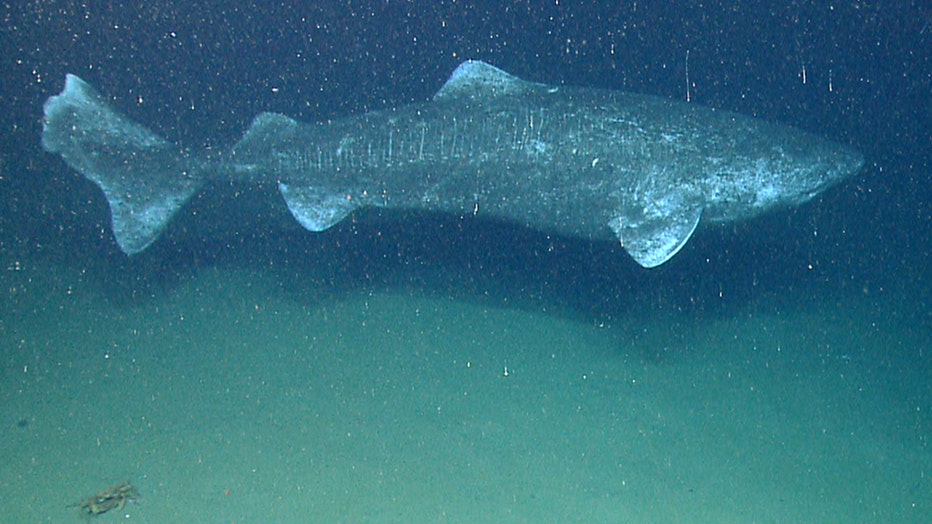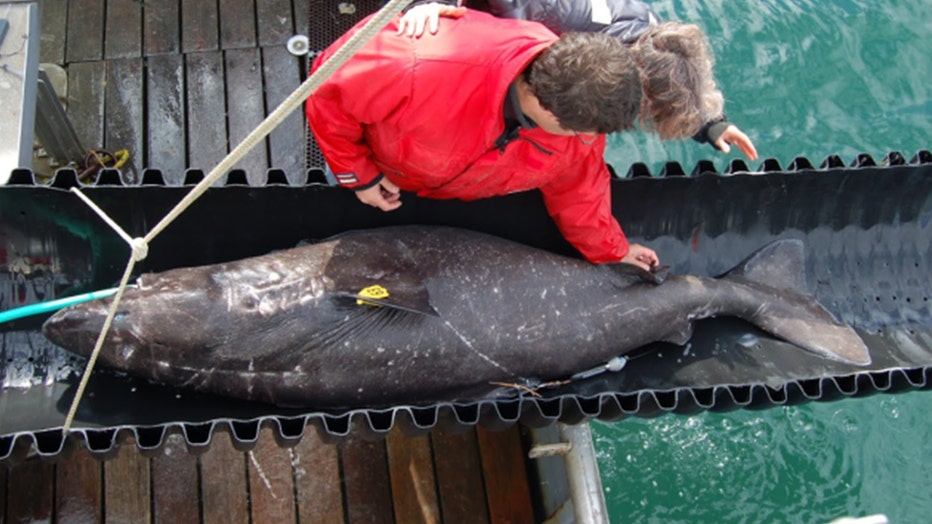Pacific sleeper shark: Study analyzes ‘possibly the largest predatory fish' in ocean
'Shark bite capital of the world'
LiveNOW's Andrew Craft spoke with FOX 35 Orlando reporter Connor Hansen about the rash of shark attacks in New Smyrna Beach, Florida. The city, which is nicknamed the "shark bite capital of the world, has had three attacks in the last month. More LiveNOW from FOX streaming video
SILVER SPRING, Md. - A new study is shedding light on NOAA’s steps toward better understanding the Pacific sleeper shark – "possibly the largest predatory fish in the ocean."
Researchers at NOAA Fisheries compiled knowledge from various sources to provide new insights into its biology and ecology. They identified and prioritized research needs to better assess and manage the species.
"My co-authors on the paper have been deeply involved in new research on this species, including improving estimates of catch and biological characteristics such as how quickly they grow and when they mature," Beth Matta, research fisheries biologist at the agency’s Alaska Fisheries Science Center, told FOX Television Stations. "We wanted to create a one-stop shop for information on Pacific sleeper sharks – a resource that others can use."
The researchers’ first step was to scour existing literature to find all that was known – and not – about this species. According to the center, the search uncovered many obscure resources.

Greenland Shark photographed at 2,940 feet depth by a remotely operated vehicle. (Credit: NOAA Office of Ocean Exploration and Research)
"Some of them were more than 100 years old," Matta said.
The study, published on April 14 in the journal SpringerLink, borrowed some information from Greenland sharks. NOAA Fisheries said the two species are so closely related that they can interbreed and are difficult to distinguish. However, the Greenland shark is much better studied because it has a long history of being fished for its liver oil and meat.
However, much of the recent data came from the center. The researchers partnered with Fisheries and Oceans Canada, who provided additional data.
Pacific sleeper shark data
According to the study, the Pacific sleeper shark, named for its sluggish nature, lives throughout the Pacific Ocean. It has been found in shallow intertidal zones, and sighted by submersibles at depths beyond a mile underwater. While it is rare, the sharks are encountered by humans most often as unwanted bycatch on commercial fishing vessels.

Pacific sleeper shark photographed at 3,125 feet depth by the remotely operated vehicle, Deep Discoverer. (Credit: NOAA Office of Ocean Exploration and Research)
"It was surprising to learn that very few mature Pacific sleeper sharks are encountered during surveys or in fishing operations. This leads us to believe they may be occupying deeper waters of the ocean that are hard to sample using conventional methods," Matta told FOX.
Like many other sharks, the Pacific sleeper shark likely grows slowly, matures late, and has a long lifespan and low productivity. It is speculated that adult females are 12-14 feet in length, and their maximum length may be more than 23 feet.
Pacific sleep shark eye lenses analyzed
Radiocarbon aging of the eye lenses of a 10-foot Pacific sleeper shark indicated that the growth rate was very slow. However, it was still twice as fast as that of Greenland sharks, which can famously live up to 400 years.
A 14-foot deceased female caught "by sheer awesome luck" in the Aleutians last summer provided a rare opportunity to study a potentially maturing female Pacific sleeper shark.

An eye lens collected from a Pacific sleeper shark for analysis to determine the shark’s age. (Credit: NOAA Fisheries)
"We have the eyes – they’re the size of cantaloupes," co-author Cindy Tribuzio said. "We hope to do bomb radiocarbon analysis on the eye lenses to determine the age."
An immature female was found to be at least 35 years old. "That indicates not only extreme longevity, but also delayed maturity," Tribuzio said. "All those pieces together suggest a high susceptibility to becoming overfished."
Matt continued: "We are excited to continue our research into how old Pacific sleeper sharks can get. Our preliminary findings suggest that they could be at least 50 years old when they mature and reach even older ages."
Pacific sleeper sharks found in Alaska, Taiwan and Russian waters
The researchers also discovered that fewer Pacific sleeper sharks have been observed in recent decades off Alaska and Taiwan, while more have been seen in Russian waters.

A Pacific sleeper shark pulled up alongside a research boat for catch and release. This shark was successfully released and able to swim away on its own. (Credit: NOAA Fisheries)
NOAA Fisheries said new genetic evidence suggests that the Pacific sleeper shark is one big stock in the entire Pacific Ocean, from Alaska to the south end of the southern hemisphere.
"We used to think there were three large species in the genus: Pacific sleeper shark, southern sleeper shark, and Greenland shark," Matta said. "Now we know the southern sleeper shark is not genetically distinct."
Evidence also pointed to a potential critical nursery habitat for Pacific sleeper sharks in the Bering Sea. Surveys have encountered aggregations of young sharks, and recent genetic evidence linked siblings in the area.
Experienced surfer recalls shark encounter
Surfer Matt White talks about his first encounter with a shark despite his decades of experience on the water. (Credit: KHON)
"With the information we compiled in this study, we were able to demonstrate the need to prioritize Pacific sleeper shark assessment efforts," Tribuzio continued. "And that we need to think out of the box on how to manage this species given its vulnerability and challenges to assessing it."
The center said it will continue to fill knowledge gaps for Pacific sleeper sharks, including longevity estimates, bioenergetics, movements, and reproduction.
"That so many scientific discoveries are still waiting to be made," Matta added. "There is so much we still don't understand about the deep ocean."
This story was reported from Los Angeles.

